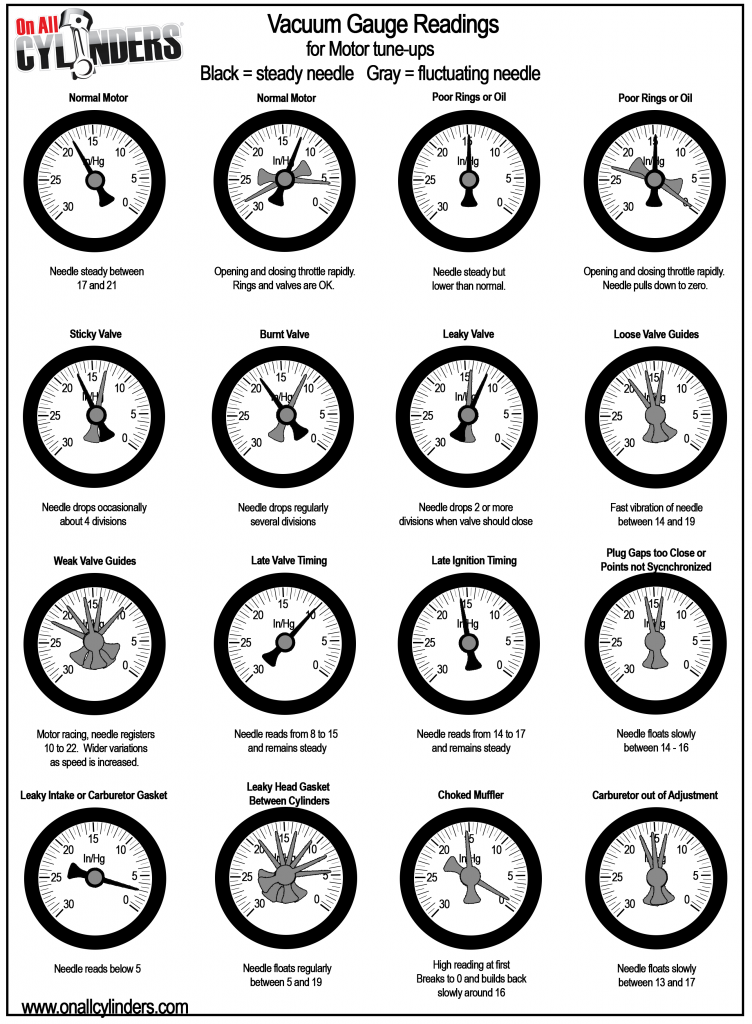Intake manifold vacuum is a key indicator of engine performance.
By measuring vacuum under different engine loads and conditions, you can track down problems within your engine and make the necessary adjustments or repairs. The key is having a reliable engine vacuum gauge and then knowing how to read it properly.
We’ve said it before, but an engine vacuum gauge is an extremely valuable tool. It’s so valuable, in fact, that OnAllCylinders contributor Lori Sams put together this visual cheat sheet to help you understand common gauge readings.
Worn piston rings? Bad head gasket?
Find out what your vacuum gauge is trying to tell you below.


Love these articles, Most new tech have no clue about using a vacuum gage. My dad taught me growing up. I still use them on today’s new cars
Your so clever.
*you’re
RE:VACUUM GAUGE READINGS/NEEDLE STEADY BUT LOWER THAN “NORMAL”, THE ENGINE WOULD BE CONSIDERED NORMAL IF & WHEN HOTRODDED WITH A CAM OF MORE DURATION & MATCHED RELATED PARTS. RICK D.
My grandfather who was a Rolls Royce trained engine specialist used a vacuum gauge as a primary gauge In WW1the vacuum gauge was the primary gauge in all aircraft The point being no matter how old or how new as long as its an internal combustion engine you need to consult a vacuum gauge. When OBD1 first came out I stupidly thought that it would include all sorts of windows to the soul of the engine! I thought you would plug into one ALDL and get Vacuum ,Timing engine temp load , blow buy all sorts of usefull stuff need less to say I was disappointed However anyone trained with a vacuum gauge can read the engine Start there
[…] Re: Lots of 454 Issues… Try perusing this link.Also,what are the head casting numbers? Vac Visual: Quick Guide to Vacuum Gauge Readings – OnAllCylinders GenVI 454,Autogear M-22W,Moser 12 w/3.42s '67 Malibu,468 w/powerglide Project- […]
change week to weak,
spelling on first page.
You can also set the timing with a vacuum gauge
is the poster for sale? i teach automotive technology and would like one for my class room
[…] and fans on Summit Racing’s Facebook page suggested covering things like firing orders and vac gauge readings. We’ve opted to equip novice mechanics enrolled in our Hot Rod Home School with a few tools […]
I’m a certified tech with 30 years experience who wants to point out an error in your article.
The top right gauge example is not correct. Needle dropping quickly to zero upon the quick opening to full throttle is perfectly normal.
Thanks
R
You are right, fast throttle opening the needle drops to zero,
Can I get a copy of the Vacumn guage read out chart?
Regards
John.
Hey John, if you’re using a PC, you can just right-click on the chart and select “Save Image As…” to save the file to your desktop. From there, you should be able to print it out.
My vacuum example isn’t listed on the chart. What does very fast flutter in a range of 1/2” at normal vacuum number mean? 19.5 to 20 very fast Thanks
Are you talking about at idle? A fast fluctuation at idle could point to worn valve guides. Here’s another story that may help out too.
Quick Tech: How to Read a Vacuum Gauge to Pinpoint Engine Problems
Corran Vincent says:
I’m pulling 14 on an old 28 DeSoto. not sure on compression ratio but probably 5-1 or could be 6 -1. How does that sound.
Thanks